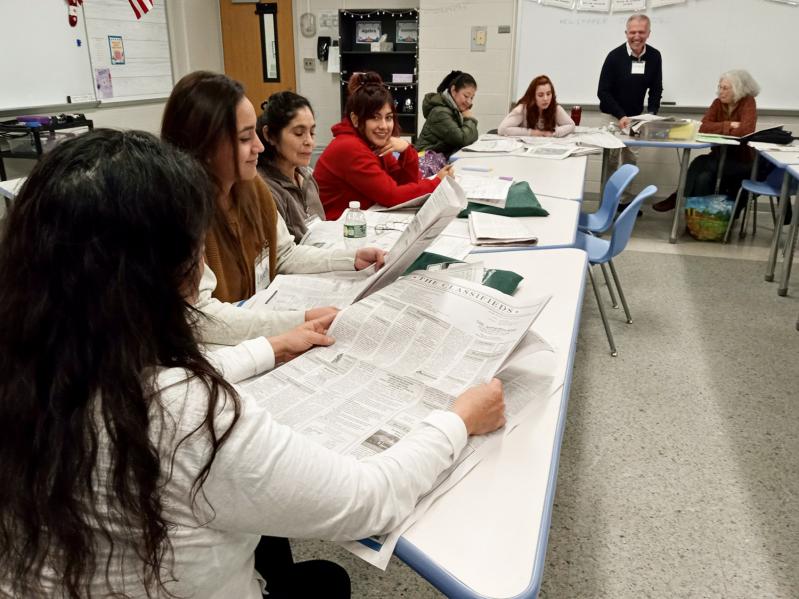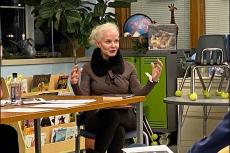It’s black and white and it’s read all over — including by a group of English-learning adults who gather weekly at a classroom in East Hampton High School for a night-school language immersion lesson featuring The East Hampton Star.
Andrew Visconti of East Hampton teaches the weekly class with fellow longtime East Hampton resident Leslie Harris. He’s a board member and volunteer teacher with Ruta 27, an English as a second language program that meets Thursday nights at the school for two-hour lessons.
Every week Mr. Visconti assigns his students — mostly from Spanish-speaking countries, but with a Polish immigrant in the mix — to find an article that they’re interested in and take notes on what they’ve read. Then they come to class and tell one another about the article and why it stood out for them. The Star’s nationally-renowned crime pages are a big and repeat hit for the students.
“We had tons of fun with the story you published about the two ladies in Sag Harbor who parked their identical white cars on Main Street and by mistake drove away with the other woman’s vehicle,” Mr. Visconti said recently as he gave the newspaper a heads-up about his Level 5 (out of 6) E.S.L. class and invited a staffer to attend.
“In this class we use The East Hampton Star to learn, to study,” he explained, “so that the readers who read The Star will know that their newspaper is also used by the Latino community . . . and the Polish community,” Mr. Visconti said with a laugh. The result is a class that on one recent night was equal parts media criticism lab, civic engagement exercise, and nuts-and-bolts English-language instruction.
Every week Mr. Visconti buys a bundle of 15 East Hampton Star newspapers and breaks them out for his students at the beginning of class.
The class then dissects an article or articles from the previous week’s paper. Mr. Visconti is on the constant lookout for teachable moments when it comes to explaining the vagaries and idiomatic peculiarities of the English language.
It’s black and white and it’s read all over — including by a group of English-learning adults who gather weekly at a classroom in East Hampton High School for a night-school language immersion lesson featuring The East Hampton Star.
Andrew Visconti of East Hampton teaches the weekly class with fellow longtime East Hampton resident Leslie Harris. He’s a board member and volunteer teacher with Ruta 27, an English as a second language program that meets Thursday nights at the school for two-hour lessons.
Every week Mr. Visconti assigns his students — mostly from Spanish-speaking countries, but with a Polish immigrant in the mix — to find an article that they’re interested in and take notes on what they’ve read. Then they come to class and tell one another about the article and why it stood out for them. The Star’s nationally-renowned crime pages are a big and repeat hit for the students.
“We had tons of fun with the story you published about the two ladies in Sag Harbor who parked their identical white cars on Main Street and by mistake drove away with the other woman’s vehicle,” Mr. Visconti said recently as he gave the newspaper a heads-up about his Level 5 (out of 6) E.S.L. class and invited a staffer to attend.
“In this class we use The East Hampton Star to learn, to study,” he explained, “so that the readers who read The Star will know that their newspaper is also used by the Latino community . . . and the Polish community,” Mr. Visconti said with a laugh. The result is a class that on one recent night was equal parts media criticism lab, civic engagement exercise, and nuts-and-bolts English-language instruction.
Every week Mr. Visconti buys a bundle of 15 East Hampton Star newspapers and breaks them out for his students at the beginning of class.
The class then dissects an article or articles from the previous week’s paper. Mr. Visconti is on the constant lookout for teachable moments when it comes to explaining the vagaries and idiomatic peculiarities of the English language. At a class a few weeks ago the students reviewed recent reporting in the paper on the Balenciaga handbag heist from March, a crime saga involving the theft of $94,000 in handbags from the store.
He asks of the class: What is Balenciaga? There are no wrong answers: It’s a shop. It’s a luxury shop. Another student chimes in: It’s a brand. Yes, yes, yes!
Mr. Visconti, an enthusiastic and indefatigable man whose own accent is less Italian than Irish — you have to listen closely to pick it up — also used that story to pursue a discussion on the various synonyms for handbag — purse, pocketbook — to aid in expanding the students’ vocabulary.
Natali Caballero stood at the whiteboard at the beginning of the class as it dived into the Balenciaga story — and she posted questions of the j-school “who-what-where-how-when-why” variety about various aspects of the caper. Where is Balenciaga? What happened? What is a handbag?
Following the Balenciaga breakdown, the class moved to a discussion of a recent full-page advertisement taken out by East Hampton Village Mayor Jerry Larsen that explained the new drill for getting annual nonresident beach permits for ocean access at the five village beaches.
The permit is $750 for nonresidents of the village, but for one day will be offered for $500 for residents of East Hampton Town. Mr. Visconti used the ad to, among other things, spell out the semantic and literal distinction between East Hampton Town and Village, while the students agreed that either option was rather pricey. It appears that bemused irony may be the universal language of humans, based on their reactions.
“It’s insane,” said Ms. Caballero
“That’s not normal,” said another.
Mr. Visconti used the advertisement to spell out the difference between an article and an ad, leaving the higher-concept advent of the hybrid and advertiser-friendly “advertorial” for another day.
For now, he wanted to know: How many people go to our beaches?
Ms. Caballero said never — she prefers going to the swimming pool at the Y.M.C.A. East Hampton RECenter with her child, and in English that was less halting than arch, said she’s just not interested in all that sand.
As the class continued, it became a sort of cross-discipline educational opportunity for participants, Mr. Visconti, and the East Hampton Star reporter in attendance.
Concepts like “media literacy” (alfabetizacion mediatica), “fake news” (noticias falsas), “the paper of record” (el papel de registro), were broadly invoked, while at the nitty-gritty level of language, the subtle but critical distinctions between, say, the Spanish word “historia” and the English word “story” were dissected: “It’s a perfect mistake to make because it’s very confusing,” said Mr. Visconti.
“In the newspaper you have an article or a story — but not a history,” he explained, bringing to mind the old Mark Twain saying that the difference between the right word and the almost right word is the difference between lightning and a lightning bug.
Another teachable moment emerged later in the class when discussion turned to the classified section in The Star, and in particular the notices announcing yard sales. Mr. Visconti was again able to compare an almost-right word to the wrong word when discussing estate sales.
In Spanish “estado” means “state,” but it’s close enough to the English word “estate” to cause confusion — which he handily addressed and dispensed with for the students.
Mr. Visconti had just returned from a wedding in Brazil that day, he told the students — and told them the following week’s assignment was to write a composition about any experiences they may have had at a wedding. Plus they were told to read an East Hampton Star feature about the World Cup and be prepared to discuss it.




